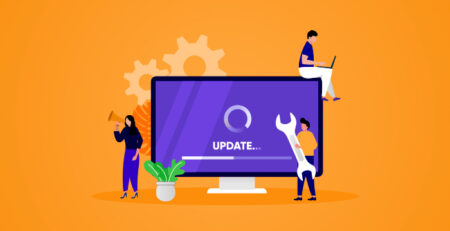What Is Buyer Intent Data And How To Leverage It In Your B2B Marketing Strategy?
When B2B buyers are considering a purchase, the amount of time they spend with potential suppliers is only 17 percent. Where do they spend the rest of their time?
Online and offline, gathering information independently.
That’s right!
This means that B2B buyers can research products and make a decision before talking to a salesperson.
So, how can you intercept a buyer in an active buying journey and position your product or service as the best option?
By using B2B buyer intent data.
Want to know more about how you can leverage buyer intent data into your B2B marketing strategy? Keep reading to find out.
What Is Buyer Intent Data?
In marketing, buyer intent data refers to buying signals that help marketers identify potential buyers actively looking for solutions similar to what your company offers.
Imagine for a moment that you’ve tapped into this data and know exactly who’s likely to buy and when. You also get insights about where the prospect is on their buyer’s journey. You can reach the right people, find what they need, and tailor solutions to address their pain points.
That’s what buyer intent data tells you.
In the current marketplace, you can no longer afford to create inbound programs and hope for prospects to reach out. You need to actively gather insights that give you an inside look into the prospective buyer’s signals, and focus on the right target, at the right time.
For example, a buyer searching for a time-tracking solution may infer they have a relatively low purchase intent. However, if the buyer searches for ‘the best time-tracking solution vendors,’ you can tell the company has a medium to high purchase intent.
Types of Buyer Intent Data
Now, you might be wondering where intent data comes from. Well, there are three key types of buyer intent data, depending on how they are collected:
First-party intent data
Also known as internal data intent, this type of data is collected in-house via a marketing automation platform or a web tracking application. The data can be collected from a customer relationship management (CRM) system or from other avenues like subscriptions, social media, email communications, surveys, questionnaires, and so on.
Some of the common web tracking applications include:
- Google Analytics
- CrazyEgg
- Clicky
- Bing Webmaster Tools
Internal Data Intent is valuable to marketers since they control what they collect and how they collect it, meaning they have full access to it. Plus, as a marketer, you can identify possible interests, buyer stages, and more.
On the downside, first-party intent data limits your reach. You don’t have a way to reach prospects interested in your solutions but haven’t discovered your website yet.
Second-party intent data
Second-party intent data is basically first-party intent data you purchase from another company. Review sites like G2 and TrustRadius are good examples of companies that sell first-party intent data.
Third-party intent data
Third-party intent data, also known as external intent data, is data sourced from external vendors. This data provides purchase intent signals from across thousands of websites, showing engagement with competitor brands.
Access to this vast data provides a wider view of an account’s interest and purchase intent. It’s useful when highlighting intent on particular topics and sites relevant to your campaign focus.
Why Consider Buyer Intent?
As a marketer, you don’t want to waste your resources targeting someone who isn’t interested or won’t need to purchase for a long time. You want to maximize sales and ROI, and that’s where buyer intent comes in.
Intent data takes the guesswork out of the equation and allows you to pinpoint intent to purchase at the right time. As a result, you can target your engagement with greater accuracy to produce satisfactory results.
How to Use Intent Data in B2B Marketing
Buyer intent data empowers you to tailor your marketing strategy to a perfect audience at the exact right time. The data feeds you unrivaled insights into your prospect’s behavior, enabling you to see hidden opportunities and leverage them to win conversions.
So, what are some of the ways a business can leverage intent data to boost ROI?
1. Content creation and optimization
Intent data helps you create customized messaging and content to better attract, engage, and convert prospects. For example, using Google Analytics and Search Console, you can see what search queries people are using to arrive at your site. You can then curate new content to meet these search queries.
Let’s say a buyer is searching to “compare” the best time-tracking solutions. You can create a detailed guide on your website that walks the prospective customer through the various types of time trackers, along with the purchase process.
That way, you can guide the conversation by delivering to buyers exactly what they are searching for. Chances are, they will engage with you further and provide follow-up opportunities.
2. Better timing and relevance
Intent data sheds light on where a buyer is in the buying process. By getting access to this data, you can follow up with relevant, timely messaging, such as demos, trials, educational material (PDF or eBook), and other incentives.
Subsequently, the data can help push a buyer into the decision stage and contribute to faster lead conversion.
3. Prioritize sales outreach based on prospect movement
A Gartner survey found that prospects spend 50 percent of their time seeking information from third-party sources. Having access to buyer intent data makes it possible to uncover the prospect’s movement and prioritize sales outreach based on those signals.
Your sales team doesn’t have to wait for buyers to complete an action or fill out a contact form to identify prospective buyers.
4. Personalize website experience for users
Users can interact more with a site that’s easy to navigate and find what they are looking for. Therefore, personalizing your website for a better user experience can attract better engagement.
Buyer intent data can help you achieve this. Based on your users’ activities, the pages they view, and how they generally interact with your website, you can serve them customized content to motivate them to take action. Maybe you want them to fill out a form so they can get a call back from one of your sales reps or try your product for free.
5. Segment your audience
B2B intent data can be used to segment your audience into various groups to define their stage in the buying process. Categories such as qualified leads, warm leads, and cold leads enable you to improve your sales and marketing strategies to better match the customer journey.
We all know that not everyone who interacts with your business is an active buyer. To avoid wasting time and money on such leads, intent data helps you filter your audience accurately to ensure efficient use of resources.
6. Reshape your account-based marketing campaign
Account-based marketing (ABM) is about understanding your customers and connecting with them through their areas of interest. Building this relationship is vital to the sustenance of your business.
Intent data can help marketers build relationships with the right prospects.
Understanding the B2B buyer intent data insights can prove valuable in helping you create highly personal and specific ABM strategies that have a higher impact on customer engagement.
With B2B intent data:
- Your sales and marketing team can determine which target accounts are active in-market for your products or services, and those that are not.
- You and your team can prioritize engagement and resource allocation on the accounts with the most potential, based on their interest levels.
- You can better adapt messaging, content, and resources to align with specific pain points of the target account showing intent.
7. Identify and reduce customer churn rate
Even after you’ve successfully converted prospects to clients, you need to watch out for potential customer churn. Continuing to leverage buyer intent data can help you identify clients researching alternative solutions or competitors and take steps to retain them.
For example, you can request feedback from those clients to check what could be the problem. Maybe they encountered issues with your solutions or are considering switching to a different provider. Either way, buyer intent data can help you identify gaps and guide future product development.
8. Better targeted advertising
Buyer intent data provides strong signals on a lead’s next movement, which makes it possible to capitalize on them using targeted advertising. Crafting custom and accurate messages and sending them out to people who already show interest in your product/service improves the chances of conversions.
In other words, intent data makes it possible to create fire ads that appeal to your B2B audience.
Wrapping Up
There you have it! B2B buyer intent data is essential to boosting conversion rate, retaining customers, and increasing ROI. It can also help you review your sales and marketing efforts and devise better strategies.
In today’s highly competitive market, customers expect personalized content and relevant information, as well as communication from sales reps, to help them make a purchase decision. That’s what makes buyer intent data even more impactful.










